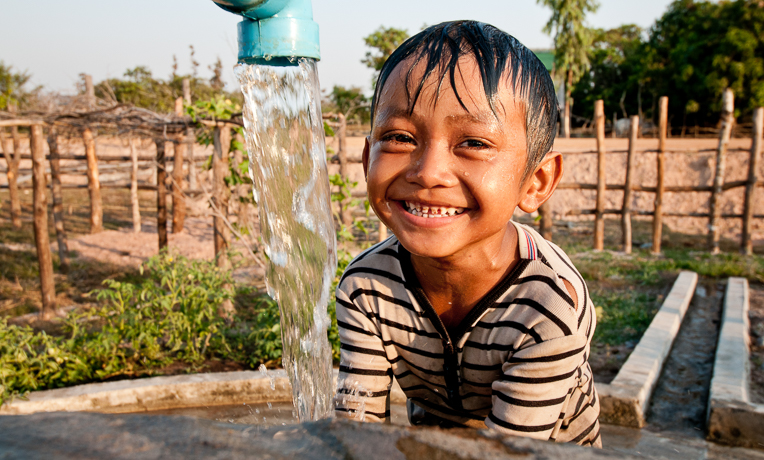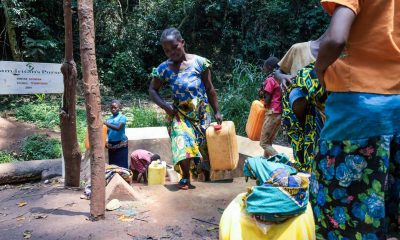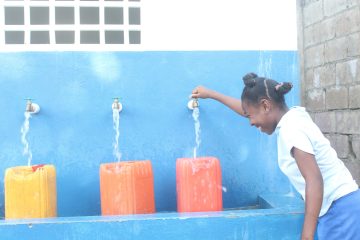Clean water at a school in Cambodia provides children with an opportunity for education
Andrew Conard works with Samaritan’s Purse in Cambodia as a water, sanitation, and hygiene program manager.
What if you sent your first grader to a school without any toilets or clean drinking water? What if your child didn’t even know how to use a toilet? American families take clean water and toilets for granted, but they are unheard of in some Cambodian schools.
This is the story of one school and how the community stood up to take action and improve the lives and education of their children.

Children at Rothanak Raem Primary School didn’t have any clean water or any options for using the toilet. Many of them didn’t even know how to use one.
For five years, enrollment rates at Rothanak Raem Primary School had steadily dropped. The community was losing faith in the school because the conditions of the school were so poor. The grass and bushes were overgrown, and even though Samaritan’s Purse has been working in Poipet for several years, we didn’t see the school until a recent survey.
The problems at this school were a result of poverty and poor water, hygiene, and sanitation in the community. The school did not have any water for children to drink, and the toilets were not functional. We could see the poor sanitary conditions of the schoolyard, which had been used as a latrine.
Many students had diarrhea, and the average student missed class at least once a month because of illness. In our baseline survey, 17 percent said they practiced open defecation at the school.
Samaritan’s Purse began working with the school in 2013, providing a clean water system and toilets with sinks for hand washing. The teachers were trained on educating the students on the importance of drinking clean water, washing hands with soap, and using a toilet.
We also provided training on how to raise funds in their community and use the money for maintaining the water and sanitation system provided. After the training, the teachers called a meeting, inviting all the parents and community leaders. They used this opportunity to talk about the need for financial support for the school.

After the school got access to clean water, enrollment rates increased.
The principal showed the parents the improved environment and encouraged the parents to send their children to study. In return, he promised to be dedicated to both the education and the health of the students.
Developing the School
The next year, enrollment shot up 21 percent, from 372 to 450 students. Teachers told Samaritan’s Purse staff members that the increase was directly related to the toilets and clean water. No other school in the area had such nice facilities.
“Thank you so much for teaching my child how to wash their hands before eating and after using toilet,” one parent said. “Now when they are at home, they remind their brothers and sisters to wash their hands.”
With this increase, a new problem arose: space for the additional students. The teachers became worried about the space available for the students to study.
However, this brought an opportunity for more development of the school grounds. From the community’s financial support, the principal planted trees, made swings for the children, and continued to seek funds for more classrooms.

Samaritan’s Purse has a project in Cambodia called Water for Kids, which works to provide clean water and hygiene knowledge to children who don’t otherwise have it.
“The water and sanitation improvements are not only bringing good health to the students but have started a chain reaction of support from the community because they can see immediate changes,” said Mr. Horn, the vice principal. “Thank you from our hearts, Samaritan’s Purse, for serving the poor and for those who gave in Jesus’ name to help this school.”
For me, I have always loved serving and teaching children, which is why I love Samaritan’s Purse and this project.
Now that I am a father, I feel even more passionate about it and hate to see children suffering. My heart breaks when I see the difficulties they have. I want to do all I can to help, even though it is overwhelming that there are so many needs. It often feels like trying to feed the 5,000 with only five loaves of bread.
But, as the body of Christ, we are called to a task that is bigger than can be accomplished by us in order for the riches of God’s glorious grace and love to be made known.
It’s a constant reminder of my need to surrender and trust Him to work His miracles in and through me. I love how God always keeps His promises. He is always here for us no matter where we are—even in the darkest night.






